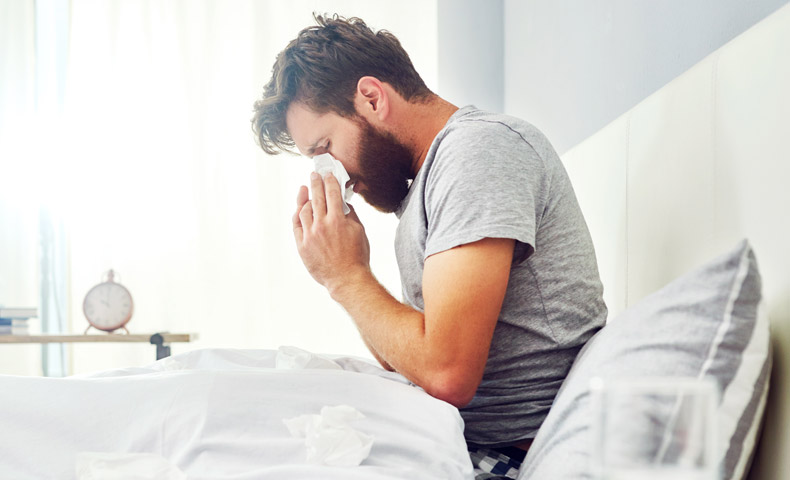
[Image description: The image shows a man sitting in bed with a tissue. He wonders if he has a sinus infection.]
You had a cold and thought you were on the mend — but now you have a fever, and pressure behind your eyes. Or maybe you’re taking antibiotics for a urinary tract infection (UTI), and now you’ve developed new itching and irritation.
These could be secondary infections — infections you get after you’ve had, or received treatment for, a different health concern. Getting a secondary infection can be frustrating (you thought you’d be better by now!), and in some cases more serious than the original condition. It’s important to be aware of when you might be dealing with more than your initial illness so you can get care if you need it.
Here are three of the most common secondary infections and how to recognize them.
Sinus infection (sinusitis)
Your sinuses are air-filled pockets in your face. A sinus infection can occur if these spaces get inflamed. If the swelling keeps mucus from draining, germs might grow. Viruses are the most common cause of a sinus infection, but bacteria can be the culprit especially in a secondary infection.
A sinus infection can be secondary to a common cold, but you can also get one if seasonal allergies cause swelling in your sinuses. Symptoms include:
- Stuffy nose
- Pain or pressure in your cheeks or forehead
- Fever
- Cough
- Fatigue
- Mucus draining in the back of your throat (postnasal drip)
See a doctor if your symptoms are severe, last for more than 10 days without getting better or start to improve and then get worse. You’ll also want to get care if you’ve had a fever for more than 3 to 4 days. Most sinus infections get better on their own. If yours doesn’t, a doctor may prescribe antibiotics.
Yeast infection
Vaginal yeast infections are usually caused by a fungus, called candida, that lives in our bodies along with other germs. Normally, our immune systems keep these germs in balance but taking antibiotics can kill the “good” bacteria that keep candida in check — which can sometimes lead to a secondary infection. The overgrowth of yeast can cause:
- Itching or burning
- White discharge
- Pain when urinating or having sex
To help prevent yeast infections, keep the area dry and wear cotton underwear. If you have diabetes, you’re at higher risk of getting yeast infections, so try to keep your blood sugar under control. Some studies have suggested that taking lactobacillus acidophilus capsules or eating yogurt may ward off yeast infections, but more research is needed.
Vaginal yeast infections can be treated with over-the-counter or prescription medications. Even if you’ve had a yeast infection before, it’s a good idea to check with a doctor before using over-the-counter medications. If it’s not a yeast infection, you might delay treatment for the actual problem.
Pneumonia
Pneumonia is an infection of the lungs. It can be a primary infection, caused by bacteria, viruses (including the one that causes COVID-19) or fungi. But you can also develop bacterial pneumonia as a secondary infection, following a cold or flu or after having pneumonia caused by a virus.
See a doctor if you develop these pneumonia symptoms after having a cold or flu:
- Cough, which may produce mucus
- Chest pain when you breathe or cough
- Fever, sweating, chills
- Shortness of breath
- Rapid, shallow breathing
- Fatigue
Treatment for secondary bacterial pneumonia may include antibiotics, cough medicine to help you rest and over-the-counter pain relievers/fever reducers.
The risk of developing pneumonia is highest among children ages 2 and younger, adults ages 65 and older and people with chronic diseases such as asthma, chronic obstructive pulmonary disorder (COPD) and heart disease. If you’re in a high-risk group, talk with a doctor about getting vaccinated against streptococcus pneumoniae bacteria, a common cause of bacterial pneumonia.
Follow through, follow up
These are just a few examples of secondary infections. Whatever health concern you’re dealing with, make sure you follow the treatment plan so you can feel better. If your symptoms worsen or don’t improve, or you start having new symptoms, it’s a good idea to get care. You can see a doctor on LiveHealth Online anytime, 24/7.
Recommended Posts


